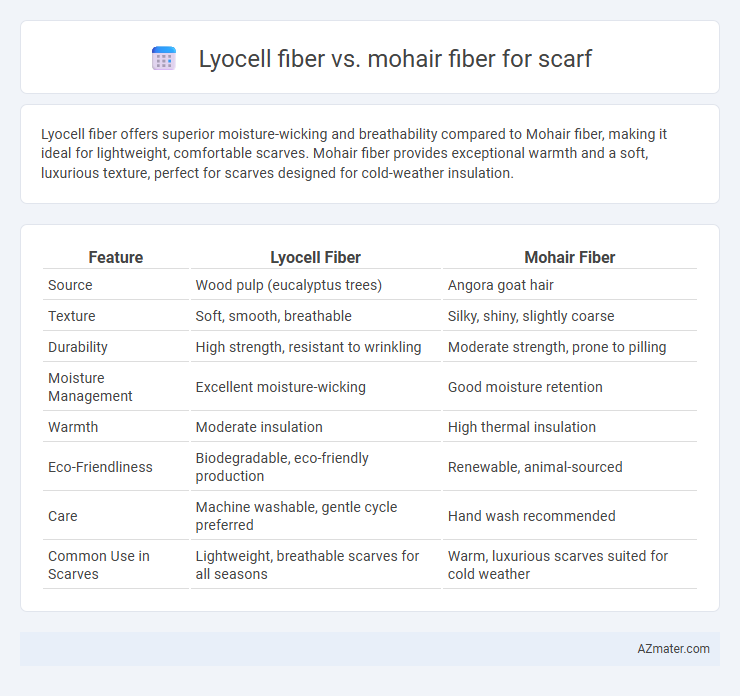Lyocell fiber offers superior moisture-wicking and breathability compared to Mohair fiber, making it ideal for lightweight, comfortable scarves. Mohair fiber provides exceptional warmth and a soft, luxurious texture, perfect for scarves designed for cold-weather insulation.
Table of Comparison
| Feature | Lyocell Fiber | Mohair Fiber |
|---|---|---|
| Source | Wood pulp (eucalyptus trees) | Angora goat hair |
| Texture | Soft, smooth, breathable | Silky, shiny, slightly coarse |
| Durability | High strength, resistant to wrinkling | Moderate strength, prone to pilling |
| Moisture Management | Excellent moisture-wicking | Good moisture retention |
| Warmth | Moderate insulation | High thermal insulation |
| Eco-Friendliness | Biodegradable, eco-friendly production | Renewable, animal-sourced |
| Care | Machine washable, gentle cycle preferred | Hand wash recommended |
| Common Use in Scarves | Lightweight, breathable scarves for all seasons | Warm, luxurious scarves suited for cold weather |
Introduction to Lyocell and Mohair Fibers
Lyocell fiber, derived from sustainably sourced wood pulp, offers exceptional breathability, moisture-wicking properties, and a silky smooth texture ideal for scarves. Mohair fiber, obtained from the Angora goat, is renowned for its luxurious softness, high luster, and excellent insulation, providing warmth without heaviness. Both fibers balance comfort and elegance, with Lyocell emphasizing eco-friendliness and Mohair highlighting natural warmth and sheen in scarf applications.
Origin and Production Process
Lyocell fiber, derived from sustainably sourced eucalyptus trees, undergoes a closed-loop production process that recycles water and solvents, minimizing environmental impact. Mohair fiber originates from the Angora goat, primarily found in South Africa and Turkey, and is harvested through shearing, producing fine, silky strands prized for their natural luster. The Lyocell process emphasizes eco-friendly cellulose regeneration, whereas Mohair relies on animal fiber collection, influencing sustainability and texture in scarf production.
Texture and Feel: Comfort Comparison
Lyocell fiber offers a smooth, silky texture with excellent moisture-wicking properties, making scarves feel cool and breathable against the skin. Mohair fiber, derived from the Angora goat, provides a soft, lustrous, and fluffy texture that offers superior warmth and a luxurious, cozy feel. While Lyocell is ideal for lightweight, comfortable scarves suitable for sensitive skin, Mohair excels in delivering insulation and a rich tactile experience for colder weather.
Warmth and Insulation Properties
Lyocell fiber offers moderate warmth and excellent moisture-wicking properties, making it breathable but less insulating compared to mohair fiber. Mohair, derived from Angora goat hair, provides superior insulation with its fine, hollow fibers that trap heat efficiently, ideal for cold weather scarves. For scarves prioritizing warmth and insulation, mohair remains the preferred choice due to its natural thermal regulation and softness.
Moisture Absorption and Breathability
Lyocell fiber exhibits superior moisture absorption and breathability compared to mohair fiber, making it ideal for scarves worn in warm or humid conditions. Lyocell absorbs moisture efficiently, transporting it away from the skin to keep the wearer dry and comfortable. In contrast, mohair, derived from Angora goats, offers moderate breathability but retains more moisture, which may feel less comfortable in sweaty environments.
Durability and Longevity
Lyocell fiber offers high durability due to its strong cellulose structure and resistance to wear, making it ideal for long-lasting scarves. Mohair fiber, derived from the Angora goat, boasts excellent resilience and natural elasticity, enhancing scarf longevity while maintaining softness. Both fibers provide durability, but Lyocell excels in moisture management, whereas mohair provides superior abrasion resistance.
Care and Maintenance for Scarves
Lyocell fiber scarves require gentle hand washing with mild detergent and air drying to maintain their softness and prevent shrinking. Mohair fiber scarves benefit from dry cleaning or careful hand washing in cool water, avoiding wringing to preserve their fluffy texture and prevent matting. Both fibers should be stored away from direct sunlight and moisture to ensure longevity and maintain their luxurious feel.
Sustainability and Environmental Impact
Lyocell fiber, derived from sustainably sourced wood pulp through a closed-loop process, significantly reduces water and chemical use, making it an eco-friendly choice for scarves. Mohair fiber, harvested from Angora goats, is biodegradable and renewable but often raises concerns about animal welfare and the environmental impact of livestock farming, including land and water consumption. Choosing Lyocell over Mohair aligns better with sustainability goals through its reduced carbon footprint and minimal environmental degradation.
Allergenicity and Skin Sensitivity
Lyocell fiber, derived from sustainably sourced wood pulp, is hypoallergenic and highly breathable, making it an excellent choice for scarves worn by individuals with sensitive skin or allergies. Mohair fiber, obtained from the Angora goat, has a natural sheen and softness but may cause itchiness or allergic reactions in people with wool sensitivity due to its protein structure. Choosing lyocell over mohair reduces the risk of skin irritation and allergen exposure, providing a comfortable wear for sensitive or allergy-prone skin.
Cost and Value Analysis
Lyocell fiber offers a cost-effective option for scarves due to its sustainable production and biodegradability, often priced lower than mohair. Mohair fiber, sourced from Angora goats, commands a higher price because of its luxurious softness, durability, and natural sheen, providing long-lasting value despite the initial investment. When comparing cost and value, Lyocell scarves suit budget-conscious consumers seeking eco-friendly textiles, while mohair scarves cater to those prioritizing premium quality and exclusivity.

Infographic: Lyocell fiber vs Mohair fiber for Scarf
 azmater.com
azmater.com